Brian Meert's Blog, page 30
October 20, 2023
What is mobile marketing?
Mobile marketing is the strategic approach to promoting products and services on mobile devices, such as smartphones and tablets, leveraging techniques like push notifications, SMS, in-app advertisements, and location-based services to engage and connect with a mobile-centric audience.
2. What is the Difference Between Mobile Marketing vs. Mobile Advertising?In the modern digital era, with the majority of interactions happening on smartphones and tablets, it’s crucial to differentiate mobile marketing from mobile advertising. While both are vital to digital strategies, they have distinct objectives and approaches.
Mobile Marketing:A holistic approach that engages potential customers on mobile devices such as smartphones and tablets. It involves various methods of connection, from SMS and email notifications to strategies tailored to mobile device users. The core aim is to foster a seamless and personalized user experience across various channels.
Mobile Advertising:A subset of mobile marketing, it specifically refers to promotional content that appears on mobile devices. This includes ads on mobile-optimized websites, sponsored content on social media platforms, and in-app advertisements.
3. Advantages of Mobile MarketingIn today’s digitally driven world, where most of us carry a mobile device, whether a smartphone or tablet, mobile marketing has never been more crucial. As a strategy that uses various channels to connect with potential customers on these devices, mobile marketing offers several tangible benefits for businesses, marketers, and consumers alike. Let’s delve into the heart of these advantages:
1. Increased Visibility and App Awareness:With the proliferation of smartphones and tablets, having a standout mobile presence is pivotal. Mobile marketing strategies, especially via mobile apps and mobile-optimized platforms, boost brand visibility, ensuring potential customers easily discover and interact with businesses.
2. Enhanced User Acquisition and Retention:Through mobile marketing messages and alerts, businesses can keep their audience engaged. Techniques like push notifications and special offers heighten user loyalty and retention.
3. Improved User Engagement and Conversion Rates:Leveraging mobile-specific content tailored for both smartphones and tablets ensures users have a seamless experience. The analytics that mobile marketing provides helps refine these efforts, leading to enhanced user engagement.
4. Real-time Communication with Users:One of the significant advantages of mobile marketing is immediate engagement. SMS marketing and location-based marketing techniques enable businesses to communicate with their audience based on the user’s location relative to specific areas, creating a more personalized touch.
Statistics about mobile marketing:Mobile accounts for over 50% of all web traffic.Mobile advertising spending is expected to reach $413 billion by 2024.Over 80% of internet users use smartphones.People spend an average of 5 hours per day on their smartphones.79% of mobile users have taken action on a mobile ad in the past month.70% of mobile searches result in an online action, such as a purchase, visit to a website, or phone call.4. Types of Mobile MarketingMobile marketing strategies have evolved to address the myriad ways people interact with content. Let’s explore these diverse approaches:
1. In-app Marketing:Mobile apps have carved a niche in our daily routines. In-app marketing takes advantage of this by placing ads, promotions, or interactive content directly within apps, ensuring the right marketing messages reach users during their in-app experiences.
2. Social Media Marketing:Social media platforms on smartphones and tablets have become central to digital interaction. Organic social media strategies foster genuine connections, while paid social ads amplify visibility and target specific user demographics.
3. Location-based Marketing:This strategy provides opportunities to reach users based on their specific location relative to predefined areas. Techniques like geofencing offer targeted marketing content when users enter or exit certain zones.
4. Search Engine Marketing:Mobile users frequently turn to search engines for queries. Organic search strategies focus on mobile-optimized content, while PPC campaigns target specific keywords to boost visibility on search results.
5. SMS and WhatsApp Marketing:Direct and often personal, SMS and WhatsApp messages allow businesses to communicate special offers or news to users, capitalizing on the immediacy of mobile communication.
6. Display Ads:These visual advertisements appear on mobile-optimized websites or within mobile apps, capturing the attention of mobile device users as they browse.
7. QR Code Marketing:By scanning QR codes with mobile phones, users can seamlessly access digital content, bridging the gap between physical and online marketing efforts.
8. Push Notifications:These real-time alerts, delivered directly to mobile device screens, engage users by offering timely updates, promotions, or personalized content.
5. How Does Mobile Marketing Work?Delving into the world of mobile marketing, we’re presented with an amalgamation of strategies and tools, each tailored to captivate audiences on their smartphones, tablets, and other mobile devices. The pathway to a successful mobile marketing campaign is paved with research, trend analysis, strategic planning, and performance analytics.
Importance of Mobile Market Research:Every journey into mobile marketing begins with understanding. Mobile marketers dig deep into mobile consumer behavior, harnessing analytics to pinpoint how users interact with mobile-optimized websites and apps. Through this, they craft marketing messages that resonate, targeting potential customers across multiple channels and devices.
Examining Mobile Marketing Trends:The ever-evolving landscape of mobile necessitates marketers to stay ahead of the curve. From the growing emphasis on in-app marketing to the nuanced strategies in SMS and email marketing, understanding and adapting to trends is pivotal. Recognizing the significance of emerging trends, like the increasing use of QR code marketing or mobile inbox strategies, ensures campaigns remain fresh and engaging.
Developing a Comprehensive Mobile Marketing Strategy:With research as the bedrock and trends as the compass, marketers embark on creating their mobile marketing strategy. Here, personalization takes center stage, enhancing customer engagement. Whether it’s through push notifications, social media marketing, or tailored in-app messages, the goal is always to connect on a much more personal level, enhancing the overall user experience.
Testing and Running Mobile Campaigns with Reliable Analytics:Implementation is where the rubber meets the road. Marketers use mobile campaigns to reach their audience, employing tools that offer real-time feedback. As campaigns run, mobile advertising options are optimized, ads are refined based on user location relative to specific areas, and continuous feedback is harnessed to enhance the campaign’s effectiveness.
6. Mobile Marketing StrategiesMobile marketing, a dynamic blend of creativity and analytics, allows businesses to connect with users on devices they use most: their phones and tablets. Let’s simplify the core strategies:
Multi-pronged Approach:Leveraging multiple channels, from in-app marketing to social media platforms, increases reach and potential engagement with diverse user bases.
Personalization & User Experience:Tailored content, driven by analytics, enhances user connection. It’s not just about mobile-optimized content but understanding and engaging the mobile consumer on a personal level.
A/B Testing for Optimization:Testing variations of marketing content, such as ads or emails, helps refine strategies, ensuring they resonate with target audiences.
Adaptive Learning with Analytics:Using feedback and data insights, mobile marketers adjust campaigns in real-time, staying agile and relevant in a constantly evolving digital landscape.
7. FAQ: Mobile Marketing1. What is the role of QR code marketing in mobile strategies?QR code marketing allows businesses to quickly connect users to digital content, websites, or special offers simply by scanning a code with their mobile device. It’s a bridge between offline and online marketing, and it’s becoming increasingly popular in online marketing campaigns.
2. How does SMS marketing differ from mobile push notifications?SMS marketing involves sending text messages directly to a user’s phone number, usually containing promotions or updates. Mobile push notifications, on the other hand, are messages sent by an app installed on a user’s device, often prompting them to engage with the app or delivering timely alerts.
3. Are mobile marketing and digital marketing the same?While mobile marketing is a subset of digital marketing, they aren’t the same. Digital marketing strategy encompasses all online marketing efforts, including those on desktops, while mobile marketing specifically targets users on mobile devices like smartphones and tablets.
4. How can I measure the success of my mobile ad campaigns?Analytics play a key role here. By monitoring metrics like click-through rates (CTR), conversion rates, and user engagement, you can gauge the effectiveness of your mobile ad efforts. Tools built for mobile marketers often provide comprehensive data to evaluate campaign performance.
4. Why is personalization crucial in mobile marketing?Personalization enhances customer engagement. Given the intimate nature of mobile devices, tailored content—whether it’s through in-app messages, email marketing, or mobile push notifications—can foster a deeper connection with the audience, making your marketing efforts much more impactful.
5. How do location-based marketing strategies benefit businesses?
Location-based marketing, such as geofencing, targets users based on their physical location. This allows businesses to send specific marketing messages or ads that appear to users within a certain area, making promotions more relevant and timely.
Yes, a mobile-optimized website is essential even if you have an app. While apps offer deep engagement, a mobile-optimized site ensures that users who search for your business online have a seamless experience, enhancing the opportunity to reach a broader audience.
What is m-Commerce – Mobile Commerce?
Mobile commerce, often abbreviated as m-commerce, refers to the buying and selling of goods or services using mobile devices, such as smartphones and tablets, typically through mobile apps or optimized websites. It encompasses a variety of transactions, including online shopping, mobile banking, and digital payments.
2. Why is Mobile Commerce Important?As our world becomes increasingly mobile-centric, understanding mobile commerce is paramount for businesses, advertisers, and consumers. Here’s why:
Ubiquity of Mobile Devices:Nearly everyone owns a mobile device today. With mobile phone users spending more time on their devices, m-commerce has naturally flourished. It’s not just about making a purchase; it’s about the convenience of doing so via mobile.
Growth of Mobile:As per recent trends, m-commerce sales are on a steady incline. More consumers rely on their mobile devices to shop, make purchases, and even use mobile wallets like Apple Pay and Google Pay. The statement that commerce is on the rise is an understatement regarding m-commerce.
Future-Proofing Businesses:With predictions suggesting that the future of mobile commerce is bright, businesses not optimized for mobile risk being left behind. As we approach 2023, mobile commerce trends indicate a shift towards more immersive experiences, integrated payment gateways, and even the blending of physical commerce with its mobile counterpart.
3. Examples of Mobile CommerceThe prevalence of mobile commerce, or m-commerce as it’s commonly known, has transformed the way we shop, bank, and interact with businesses. The world in 2023 is a testament to how deeply ingrained m-commerce has become in our daily lives. Let’s explore some real-world applications and decipher the nuances between mobile apps and websites.
Online Shopping through Mobile Apps:Platforms like Amazon, eBay, and many local e-retailers have comprehensive mobile apps that enable users to browse, select, and make purchases on-the-go. The mobile shopping experience is often tailored to individual user preferences, making it highly personalized.
Mobile Banking:Institutions like Chase, Bank of America, and countless others offer mobile banking apps that allow users to monitor their accounts, transfer money, and even deposit checks using their mobile device’s camera.
Digital Wallets:Apple Pay, Google Pay, and other mobile wallets have revolutionized the transaction process. Instead of pulling out a physical card, users can pay with a tap of their phone. This is a shining example of how m-commerce sales are being driven by convenience.
Social Commerce:Platforms like Instagram and Pinterest have integrated shopping features, allowing users to purchase directly from posts. This blurs the lines between social media platforms and e-commerce, all via mobile devices.
Mobile Point-of-Sale:Businesses, especially in the retail sector, use mobile devices such as smartphones and tablets as POS (point-of-sale) systems. This allows for a more flexible and dynamic selling environment.
4. Mobile App vs Mobile WebsiteThe distinction between mobile apps and mobile websites in the realm of m-commerce is crucial, and understanding the difference can inform a business’s mobile commerce strategy.
Mobile Apps:Pros:Mobile apps are designed for a seamless user experience. They can access device features, such as the camera or GPS, allowing for augmented functionalities. Push notifications in apps aid in real-time marketing and user engagement. Apps can also function offline, making them accessible at all times.
Cons:They require downloading and regular updates. Compatibility might be an issue across different devices, and the initial development can be costly.
Mobile Websites:Pros:Mobile sites are accessible across all devices with a browser, without any downloads. They’re easier and cheaper to develop and maintain than apps.
Cons:They might not offer as fluid a user experience as apps. Features are limited to what browsers can offer, and real-time interactions like push notifications are harder to implement.
To decide between a mobile app and a mobile website, businesses should consider their objectives, target audience, and available resources. For instance, an e-retailer looking to provide a consistent shopping experience across platforms might prioritize a mobile site, while a game developer would lean towards an app for enhanced functionalities.
5. What are the Types of Mobile CommerceThe rise of m-commerce in 2023 and the previous years has reshaped the commerce landscape. No longer confined to brick-and-mortar establishments or even traditional e-commerce websites, the wave of mobile commerce has ushered in a plethora of ways to facilitate trade and transactions. Understanding the different facets of m-commerce is essential for any business looking to thrive in the digital era.
Mobile Websites:Also known as m-commerce sites, these are web portals optimized for mobile devices such as smartphones and tablets. Mobile sites ensure that users have the same quality of experience as they would on a desktop, but tailored to smaller screens, often enhancing the mobile shopping experience.
Mobile Apps:Mobile applications are specifically designed software for mobile devices. They offer a more personalized shopping experience, sending users push notifications on deals, tracking their preferences, and even allowing offline browsing.
Mobile Payments:Embracing the shift to mobile, many businesses are adopting mobile payment options. This encompasses mobile wallets like Apple Pay and Google Pay, facilitating seamless transactions. It’s not just about purchasing goods; mobile payments include utilities, mobile banking, and more.
Social Commerce:With the widespread use of social media platforms, businesses are tapping into platforms like Instagram, Facebook, and Pinterest to sell directly through posts and ads. Social commerce often blurs the line between browsing and shopping.
QR Code Shopping:QR codes have paved the way for innovative shopping experiences. Scanning a code can lead a customer directly to a product page or even facilitate instant payments.
Augmented Reality (AR) Shopping:Mobile apps are now integrating AR technology, allowing users to “try” products before purchasing. For instance, trying out furniture in a virtual rendition of one’s living room.
6. What are some Steps to Enhance Mobile Experience?The ubiquity of mobile devices in 2023 has made it imperative for businesses to refine their mobile experiences. After all, the world of mobile commerce, or m-commerce, is more than just a trend; it’s a transformative shift in the way commerce operates. Whether a business opts for a mobile app or a mobile website, the user experience is paramount.
Here, we’ll delve into the best practices for optimizing m-commerce experiences and pinpoint common missteps to avoid:
Responsive Design:This is the foundation. Ensure that your mobile site or app is optimized for mobile devices of all sizes, from smartphones to tablets. Users should navigate seamlessly without any frustrating hitches.
Fast Load Times:Mobile users, especially those shopping via mobile, are often on-the-go. Ensure your mobile site or app loads swiftly, reducing the chances of potential customers abandoning their carts.
Easy Navigation:Simplify your menu and search functionalities. Overloading users with too many options can be overwhelming. Prioritize clarity and ease of use.
Clear Call-to-Action (CTA) Buttons:CTAs like “Buy Now”, “Add to Cart”, or “Checkout” should be prominently placed and easily clickable. Remember, the mobile experience is often touch-based.
Streamlined Checkout Process:Reduce the number of steps required to complete a purchase. Incorporate mobile payment options like Apple Pay, Google Pay, or mobile wallets to expedite the process.
Personalized Experiences:Leverage data analytics to provide personalized shopping recommendations. Users appreciate a tailored shopping experience, which can lead to increased sales.
Integrated Social Commerce:Integrate with social media platforms. In 2023, platforms like Instagram and Facebook aren’t just for socializing; they’re potent commerce tools.
Feedback Loop:Encourage user feedback. Whether it’s through reviews, ratings, or direct feedback channels, understanding your users’ needs and grievances can guide improvements.
FAQ: Frequently Asked Questions about Mobile CommerceQ1: What is the difference between e-commerce and m-commerce?E-commerce refers to all forms of electronic commerce, including transactions made on desktops, laptops, and other devices. M-commerce, or mobile commerce, is a subset of e-commerce and specifically refers to transactions conducted via mobile devices such as smartphones and tablets.
Q2: How does mobile banking differ from m-commerce?Mobile banking is a service provided by financial institutions that allows users to conduct banking activities via mobile devices. M-commerce encompasses a wider range of activities, including shopping, making purchases, using mobile wallets, and more. While mobile banking can be a part of m-commerce, not all m-commerce activities are related to banking.
Q3: Why is a mobile-optimized website crucial for businesses in 2023?With the growth of mobile users and an increasing number of transactions conducted via mobile devices, having a mobile-optimized website ensures a seamless and user-friendly experience. It can lead to increased customer retention, better conversion rates, and overall business growth.
Q4: How do mobile wallets like Apple Pay and Google Pay fit into m-commerce?Mobile wallets, such as Apple Pay and Google Pay, are digital tools that store payment information and allow users to make transactions without physical cards. In the realm of m-commerce, they simplify the checkout process, making transactions swift and secure, enhancing the overall mobile shopping experience.
Q5: Are mobile apps better than mobile websites for m-commerce?Both mobile apps and mobile websites have their advantages. Mobile apps often offer a more personalized experience, can work offline, and can utilize device-specific features. On the other hand, mobile websites are accessible to a broader audience without any downloads. The choice between the two often depends on a business’s objectives and target audience.
Q6: How do social media platforms contribute to m-commerce trends in 2023?Social media platforms like Instagram, Facebook, and Pinterest have integrated shopping features, allowing direct purchases from posts or ads. This integration of social commerce blurs the lines between browsing and shopping, making it easier for users to make a purchase instantly without leaving the platform.
Q7: What are the main challenges businesses face in optimizing for mobile commerce?Challenges include ensuring data security, maintaining a consistent and seamless user experience across various devices and platforms, staying updated with rapidly evolving m-commerce technology, and differentiating in a saturated market.
Q8: How is the mobile shopping experience expected to evolve in the future?The mobile shopping experience is anticipated to become more immersive, personalized, and integrated. With advancements in AR, AI, and machine learning, users can expect tailored product recommendations, virtual try-ons, and more interactive features. Additionally, with the shift to mobile becoming more pronounced, businesses will focus on enhancing mobile checkouts, integrating more payment options, and providing richer mobile content.
What Is Attribution Modeling?
An Attribution Model is a framework used to assign value or credit to different touchpoints in a customer’s journey, helping marketers understand which channels or actions contribute most effectively to a desired outcome, such as a conversion or sale.
2. How Does Marketing Attribution Impact Conversion Decisions in Digital Marketing?Marketing attribution is the backbone for understanding the intricate web of interactions a customer has before they complete a conversion. It dives deep into the customer’s journey and sheds light on the various touchpoints or marketing channels they interact with.
In this way, our key takeaways include:
Detailed Customer Journey:Marketing attribution offers insights into every step a customer takes before making a decision. This might include interactions with online ads, email campaigns, social media, and more.
Informed Resource Allocation:By discerning which channels and touchpoints are most influential, businesses can make strategic decisions on where to direct their marketing resources.
Optimal Campaign Refinement:With a clear understanding of which strategies work and which don’t, companies can fine-tune their marketing campaigns for superior results.
3. How Is Attribution Modeling Different From Other Different Marketing Measurement Techniques?Unlike linear attribution or last-click attribution, which gives credit to one specific point, attribution modeling presents a more holistic view. It factors in all touchpoints a user interacts with, providing a clearer picture of a user’s journey. This is particularly vital in the age of multi-touch attribution, where a user might interact with various marketing channels before converting.
4. Why Is Attribution Modeling Important for Data-Driven Digital Marketing Strategies?Attribution modeling in digital marketing is the systematic approach used to determine how various touchpoints or marketing channels influence a customer’s journey towards a conversion. Through this method, businesses can understand the roles of different strategies, from email marketing to paid ads, in achieving specific outcomes.
Key Features and Importance:
Data-Driven Decisions:In a landscape dominated by data, attribution modeling facilitates data-driven decisions. This approach ensures marketers rely on actual performance metrics rather than intuition.
Touchpoint Analysis:Attribution offers a granular look into which touchpoints—whether they’re email campaigns, social media promotions, PPC ads, or organic search efforts—have the most substantial influence on customer decisions.
Optimization with Analytics Tools:Tools like Google Analytics and Google Analytics 4 empower marketers with the insights derived from attribution modeling. These insights help businesses discern fruitful strategies from those that need revising.
ROI Measurement:One of the core tenets of digital marketing is assessing the return on investment (ROI). Attribution plays a crucial role here, helping brands allocate their resources to the most effective strategies.
5. What Are the Challenges in Implementing Different Types of Attribution Models?Every attribution model, from first-click attribution, last-click attribution, multi-touch attribution, to more advanced ones like the w-shaped attribution or u-shaped attribution, brings its distinct viewpoint to the table. But there are challenges aplenty:
Choosing the Right Model:The digital landscape is vast, with users interacting through various marketing channels and touchpoints. The primary challenge is discerning which model or blend of models—be it time-decay attribution, linear attribution, or any other—truly captures the essence of a customer’s journey.
Integration with Advertising Platforms:Platforms like Google Ads or even more encompassing ones like a digital marketing agency’s proprietary system require seamless integration with your chosen attribution model. Ensuring that data flows without hitches between these platforms and your attribution tool is crucial.
Data Accuracy and Consistency:Accurate data collection is the bedrock of effective attribution modeling. It’s essential to ensure that touch attribution data, click attribution data, or any other relevant metrics are collected consistently without any gaps or errors.
Cross-Channel Attribution:With the surge in multi-channel marketing, understanding cross-channel attribution becomes paramount. How do you account for a user who discovers your brand through a Google ad, interacts with a social media campaign, and finally converts via an email marketing touchpoint?
Keeping Up with Changes:Platforms evolve. Take, for example, the introduction of Google Analytics 4, which offers a new approach compared to its predecessor. Adapting to these changes and ensuring your attribution models remain relevant can be a challenging endeavor.
Overcoming Model Bias:Some models, like last-touch attribution, might give undue credit to the final touchpoint, potentially sidelining the impact of each marketing effort earlier in the journey. Balancing and understanding such biases are essential to get a holistic picture.
6. How Do You Choose the Best Attribution Model for Your Business From the Common Attribution Models?Choosing the best attribution model requires a deep understanding of your marketing campaign’s objectives and the nature of your marketing efforts. If the primary goal is to raise awareness among new potential customers, a first-touch attribution model might be most appropriate. In contrast, if you’re keen to determine the specific touchpoint that seals the decision for users, the last-touch attribution model is insightful. For businesses looking to understand which marketing channels or touchpoints played a critical role in conversion, models like w-shaped attribution or u-shaped attribution can provide a comprehensive overview.
7. What Is Multi-Touch Attribution, and How Does It Differ From Other Types of Attribution Like First Touch Attribution or Last Click Attribution?Multi-touch attribution is a holistic approach that considers every interaction a user has with various marketing channels before conversion. Unlike first touch attribution, which attributes the conversion to the initial interaction or last click attribution that focuses solely on the last touchpoint, multi-touch offers a panoramic view of the user’s journey. This model allows businesses to determine the value and impact of each marketing touchpoint on the path to conversion.
8. How Do Google Analytics and Google Analytics 4 Support Attribution Modeling Reports and Model Comparison?Google Analytics and its latest version, Google Analytics 4, are pivotal tools for businesses to delve deep into user behaviors and interactions. They not only track user activity but also offer features like model comparison. This functionality lets marketers compare various attribution models side by side, thereby determining how each marketing channel performs within different models. Moreover, integration with platforms like Google Ads ensures a seamless flow of data and insights.
9. Given the Different Types of Attribution Models Available, How Has the Rise of Multi-Channel Marketing Influenced the Current Attribution Practices?The digital age has brought forth a plethora of marketing channels, from social media to email marketing and beyond. With this rise in multi-channel marketing, understanding the customer’s journey has become intricate but of paramount importance. Businesses now leverage advanced models like w-shaped attribution and u-shaped attribution to grasp the multifaceted interactions users have across these channels, ensuring they credit the marketing channels effectively.
10. What Role Do Data-Driven Attribution Modeling Tools Play in Identifying Touchpoints and Optimizing Click Attribution?Data-driven attribution modeling tools harness the power of big data and analytics. By processing vast data sets, these tools can pinpoint which touchpoints or marketing channels and touchpoints have the most substantial influence on conversions. Advanced algorithms and machine learning techniques help parse through this data, offering businesses actionable insights to refine and optimize their marketing campaigns.
11. How Do Businesses Evaluate and Evolve Their Use of Marketing Attribution Models Like Fractional Attribution Over Time?The dynamic nature of the digital world means that attribution models, too, must evolve. As new channels emerge and user behaviors shift, businesses need to regularly evaluate their chosen models. Whether it’s fractional attribution, position-based attribution modeling, or any other model, periodic assessment ensures that businesses remain aligned with current trends and maintain the relevance of their marketing insights.
How To Do a Voiceover on TikTok
Have you ever wondered how to do a voiceover on TikTok?
Voiceovers can add a fun and creative touch to your TikTok videos. Whether you want to narrate a story, add commentary, or spice up your content, TikTok voiceovers open up a world of possibilities. What’s more, it’s surprisingly easy to get started.
Let’s walk you through simple steps to unleash your inner voiceover artist on one of the most popular social media platforms.
1. Tap the + ButtonThe first step is to tap the + button. You will find it on the middle bottom part of the screen.

Film or upload the video you want to accompany your voiceover. To film a video, you should tap on the circular record button. However, if you want to upload a video you previously took, select the “upload” button.
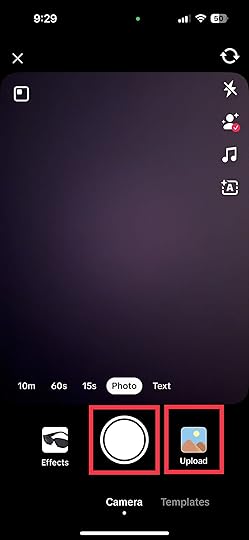
The edit button is the third icon from the top. The button will direct you to the controls, where you can alter the sound, add text, and add overlays.
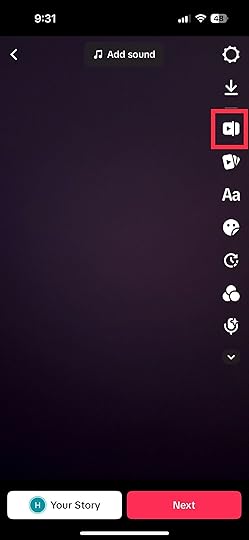
After selecting “Sound,” you will be directed to a menu bar.
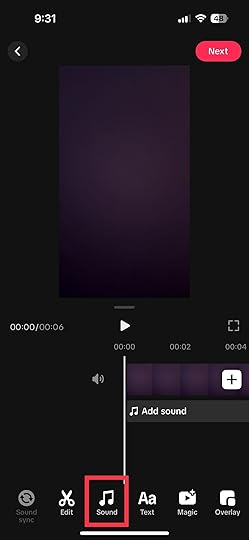
Then, select the microphone icon labeled “Voiceover.”
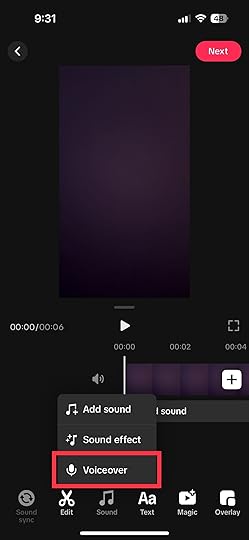
To record your voiceover, tap on the red button. Once you start recording, you will see the audio spectrum analyzer, where you can see the frequencies in the recordings.
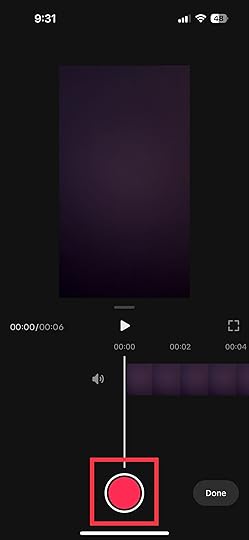
Once finished, tap “Done.”
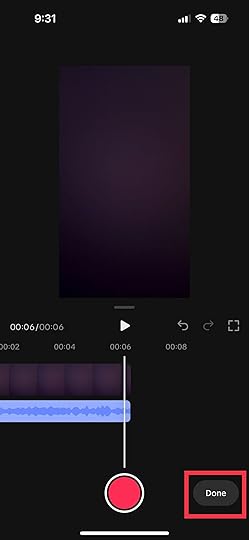
To ensure you add all the necessary information to the voiceover, preview the entire video first. To preview your video, tap on the play button indicated below.
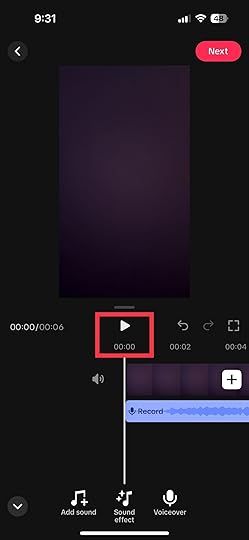
Once satisfied with the result, tap “Next.”
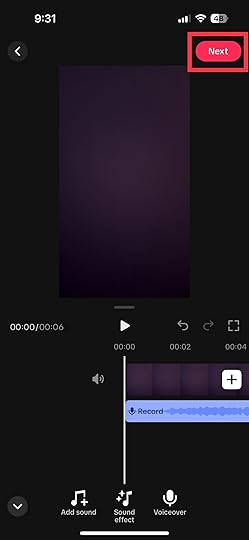
Before posting, you can add your captions and hashtags. You can also set your privacy settings, tag people, and set your location.
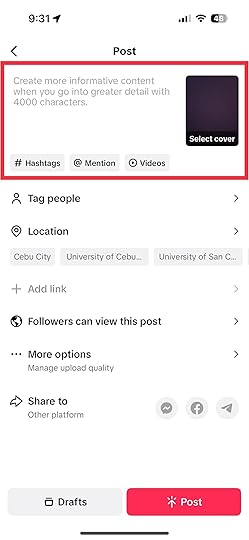
Once everything is set, tap “Post.”
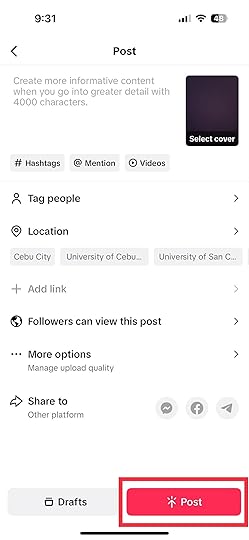
Read more: How to turn off Q&A on TikTok.
How To Make an Excellent Voiceover on TikTokCreating an excellent voiceover on TikTok can set your videos apart and engage your audience effectively. Here are some tips to help you master the art of TikTok voiceovers:
Clear and engaging script: Start with a clear and engaging script. Plan what you want to say, and make sure it fits the length and theme of your video. Avoid rambling, and keep your message concise.Background noise control: Find a quiet space to record your voiceover. Minimize background noise as much as possible, and consider using a microphone for better audio quality. You can use headphones with a built-in microphone for clearer sound.Practice and delivery: Practice your delivery to convey your message with enthusiasm and clarity. Speak naturally and at a steady pace. Remember to breathe, and if necessary, break the voiceover into smaller segments to make it easier.Sync with video: Ensure that your voiceover syncs well with the video. You can edit the timing of your voiceover by adjusting the sound and video clips within the TikTok app to create a seamless integration.Music and effects: Consider adding music or sound effects to enhance your voiceover. TikTok provides an extensive library of soundtracks and effects that can complement your content and make it more engaging.Use captions: Not all TikTok users watch videos with the sound on, so use captions to provide context or emphasize key points in your voiceover. This ensures your message reaches a wider audience.Final Thoughts on “How To Do A Voiceover On TikTok”Incorporating voiceovers into your TikTok content can elevate your videos and captivate your audience. With just a few simple steps, you can use your voice to add a unique and personal touch to your TikTok creations. Give it a try, and let your voice be the star of your next TikTok masterpiece
Are you considering running TikTok ads? Hire the best TikTok advertising agency for immediate results!
Frequently Asked QuestionsWhat is the voice filter tool on TikTok?The voice-filter tool on TikTok allows you to experiment and achieve your content’s desired voice effect. Users use this feature to change their voices’ pitch, speed, or tone to make it funnier or more entertaining.
Are there options to mute the original audio while using a voiceover on TikTok?Yes, when you record a voiceover on TikTok, it automatically reduces the original audio’s volume. You can further adjust this balance on the screen to mute the original video.
Are there tips for creating an engaging voiceover on TikTok?You should speak clearly and with enthusiasm. Match your voiceover content to the video’s theme and use appropriate voice effects to enhance engagement.
Related ArticlesHow To Turn Off Q&A on TikTok
Do you know how to turn off Q&A on TikTok?
TikTok’s Q&A feature has undoubtedly added a new layer of interactivity to the platform. But sometimes, you might want to turn it off for various reasons.
TikTok offers endless opportunities for users to interact with one another. One such feature is the Q&A option, where users can ask questions from content creators. This powerful feature can be useful to TikTok brands and creators in different situations.
This article will discuss how to turn off Q&A on TikTok.
What Is the TikTok Q&A for? Source: Canva
Source: CanvaTikTok’s Q&A feature allows creators to receive and answer questions from their audience. You can activate it with a button seen on your account’s TikTok bio.
This feature improves engagement and interaction between creators and their audiences by providing a direct channel for inquiries and responses. Also, creators can respond to these questions in video or text, creating a more interactive connection.
Read more: A guide to the TikTok ad library.
How To Turn Off Q&A on TikTok Source: Canva
Source: CanvaThe following are the steps on how to turn off Q&A on TikTok:
1. Log in to your TikTok creator account using your mobile phone.
2. Go to your profile.
4. Upon entering the profile page, you will see the icon with three lines on the top right corner of your screen. Tap on it.
4. Select “Creator Tools.”
5. Go to “Q&A.”
6. Tap “Turn Off Q&A.”
Things To Consider Before Turning Off Q&A on TikTok Source: Canva
Source: CanvaThe following are the things you should consider before turning off your Q&A feature on the TikTok app:
Impact on engagement: Turning off Q&A might affect your engagement, especially if your followers use this feature to interact with you. Before removing this feature from your profile, consider how it could impact your engagement.Audience expectations: If you have been actively using the Q&A feature, your audience may have come to expect you to utilize its feature. Hence, it would be best to communicate the changes to manage their expectations. Doing so will help avoid any confusion.Alternative communication channels: If you turn off your Q&A feature, you should set alternatives. Your followers should still have a way to interact with you.Final Thoughts on “How To Turn Off Q&A on TikTok”Turning off the Q&A feature on TikTok can help you manage your content and interactions. Whether seeking a break from constant questions or a more streamlined experience, follow our guide to get the control you need.
Looking for ways to enhance your TikTok’s visibility? Work with the best TikTok advertising agency now!
Frequently Asked QuestionsIs it best to turn off or on TikTok?While it is better to turn it on, you can turn off the Q&A feature on TikTok to manage account interactions.
Can I still receive comments on my videos after turning off Q&A?Yes, you can still receive comments on your videos even if you turn off the Q&A feature.
Does turning off Q&A affect my followers or the visibility of my profile?No. Turning off the Q&A feature does not affect your followers or the visibility of your profile. It will only turn off its functionality.
Related ArticlesOctober 19, 2023
What is ASO – App Store Optimization?
App Store Optimization (ASO) is the process of optimizing various elements of an app’s listing in app stores (like the Apple App Store or Google Play Store) to maximize its visibility, increase the number of downloads, and rank higher in search results within the stores.
2. Which App Stores Should You Focus On?While there are various app stores available, the two juggernauts are Apple’s App Store (for iOS apps) and Google Play Store (for Android apps). These platforms cater to the vast majority of mobile users globally. However, the best app store for your app optimization efforts largely depends on your target audience. For instance, if you’re targeting a global audience, especially in regions like Asia, consider optimizing for local app stores too.
3. How to Do App Store Optimization?ASO isn’t a one-time task. It’s an ongoing process that requires regular tweaks and monitoring. Here’s a complete guide to app store optimization:
Keyword Optimization:Start by researching and choosing the best keywords for your app. These should be terms users might input when searching for apps similar to yours. Incorporate these keywords naturally in your app title, description, and metadata.
Optimize Your App Store Listing:Enhance your app icon, title, and screenshots to make them more appealing. An effective app title is often a balance between a catchy name and a primary keyword. The description should clearly communicate the benefits and features of your app.
Increase App Reviews and Ratings:Positive reviews can significantly influence your app’s ranking. Encourage satisfied users to leave positive reviews and promptly address any concerns raised by others.
Regularly Update Your App: Frequent updates, which address bugs and introduce new features, show app store algorithms that your app is maintained and valued.
4. What is the Difference Between Search Engine Optimization and App Store Optimization?Both SEO and ASO aim to increase visibility and drive organic traffic, but they cater to different platforms. While SEO focuses on improving rankings on search engines like Google, ASO is tailored for app store search results. Unlike web content, which can be shared across various platforms, apps are primarily discovered within the app store. Furthermore, the keyword strategies, algorithms, and ranking factors differ between search engines and app stores.
5. What are the Key Factors that Influence App Store Rankings?Several elements influence an app’s ranking within the app store:
App Metadata:This includes your app title, description, and keywords.
Download and Engagement Metrics:The number of downloads, user retention rates, and in-app user behavior.
User Reviews and Ratings:Positive reviews and high ratings can significantly boost your app’s rank.
Update Frequency:Regularly updated apps are often perceived as more user-centric by the app store algorithms.
6. Which Tools are Best for App Store Optimization Research?There’s a plethora of app store optimization tools that can assist in keyword research, competitor analysis, and tracking your app’s performance. Some popular ASO tools include:
ASO Tool:Provides keyword suggestions, competitor insights, and optimization tips.
AppTweak:Offers ASO and market intelligence for both iOS and Android platforms.
Sensor Tower:Focuses on keyword optimization, competitive analysis, and trend insights.
7. How to Navigate the Challenges of ASO?ASO can be challenging due to the ever-changing algorithms of app stores and the intense competition. Here are some best practices:
Stay Updated:App store algorithms evolve. Regularly update your ASO strategies to remain relevant.
A/B Test:Experiment with different app icons, titles, and descriptions to see which ones resonate most with your audience.
Engage with Your Users:Encourage feedback, address negative reviews, and foster a community around your app. This not only boosts your ASO efforts but ensures long-term user retention.
8. Why is App Store Optimization Important?In today’s competitive app market, merely developing a stellar app isn’t enough. The true challenge lies in making it discoverable among millions of other apps. Benefits of app store optimization are numerous. Foremost, ASO helps your app stand out in the crowded marketplace, increasing the organic app downloads. This naturally leads to a better ROI for app developers. Also, by focusing on the right ASO keyword and understanding what app store users are searching for, developers can attract a more targeted and engaged audience.
9. Which App Stores Should You Focus On?While there are various app stores available, the two juggernauts are Apple’s App Store (for iOS apps) and Google Play Store (for Android apps). These platforms cater to the vast majority of mobile users globally. However, the best app store for your app optimization efforts largely depends on your target audience. For instance, if you’re targeting a global audience, especially in regions like Asia, consider optimizing for local app stores too.
10. How to Do App Store Optimization?ASO isn’t a one-time task. It’s an ongoing process that requires regular tweaks and monitoring. Here’s a complete guide to app store optimization:
Keyword Optimization:Start by researching and choosing the best keywords for your app. These should be terms users might input when searching for apps similar to yours. Incorporate these keywords naturally in your app title, description, and metadata.
Optimize Your App Store Listing:Enhance your app icon, title, and screenshots to make them more appealing. An effective app title is often a balance between a catchy name and a primary keyword. The description should clearly communicate the benefits and features of your app.
Increase App Reviews and Ratings:Positive reviews can significantly influence your app’s ranking. Encourage satisfied users to leave positive reviews and promptly address any concerns raised by others.
Regularly Update Your App: Frequent updates, which address bugs and introduce new features, show app store algorithms that your app is maintained and valued.
11. What is the Difference Between Search Engine Optimization and App Store Optimization?Both SEO and ASO aim to increase visibility and drive organic traffic, but they cater to different platforms. While SEO focuses on improving rankings on search engines like Google, ASO is tailored for app store search results. Unlike web content, which can be shared across various platforms, apps are primarily discovered within the app store. Furthermore, the keyword strategies, algorithms, and ranking factors differ between search engines and app stores.
12. What are the Key Factors that Influence App Store Rankings?Several elements influence an app’s ranking within the app store:
App Metadata:This includes your app title, description, and keywords.
Download and Engagement Metrics:The number of downloads, user retention rates, and in-app user behavior.
User Reviews and Ratings:Positive reviews and high ratings can significantly boost your app’s rank.
Update Frequency:Regularly updated apps are often perceived as more user-centric by the app store algorithms.
12. Which Tools are Best for App Store Optimization Research?There’s a plethora of app store optimization tools that can assist in keyword research, competitor analysis, and tracking your app’s performance. Some popular ASO tools include:
ASO Tool:Provides keyword suggestions, competitor insights, and optimization tips.
AppTweak:Offers ASO and market intelligence for both iOS and Android platforms.
Sensor Tower:Focuses on keyword optimization, competitive analysis, and trend insights.
What Is an Impression?
With the rapid growth and evolution of the digital landscape, the language of advertising and marketing has expanded, introducing many new terms and metrics that businesses and marketers need to understand. One such term that often captures the attention of those in the industry is “impression.”
1. What is the definition of an impression in the context of digital marketing?Impression denotes the number of times a specific content piece—like an advertisement or blog post—is showcased on a user’s screen, regardless of user engagement or interaction.
2. How do impressions differ from clicks?Impressions and clicks are two impressions of the digital advertising world, often used in tandem to gauge the performance of online content. While impressions measure the number of times your content has been displayed or viewed on a screen, clicks refer to the number of times a user actively interacts or clicks on the ad or content.
The distinction is crucial for advertisers and marketers. For instance, a high number of impressions coupled with a low number of clicks would indicate that while the ad or content is being displayed extensively, it might not be effectively engaging the audience, leading to potential areas of improvement in content strategy.
Furthermore, metrics like click-through rate (CTR) integrate these two concepts, calculating the ratio of users who click on an advertisement to the number of total users who viewed the ad (impressions). It offers a snapshot of how compelling and actionable the ad content is to its viewers.
3. Why are impressions considered vital in marketing strategies?Impressions act as a foundational metric in the advertising and marketing niche, offering businesses a starting point to measure brand awareness and campaign performance. They provide advertisers with a resource to:
Track and Monitor Engagement:Impressions help brands monitor how often their content is being displayed, providing a preliminary indication of its reach and the potential audience it is garnering.
Allocate Resources:By understanding which pieces of content or ads receive the most impressions, businesses can allocate resources more effectively, optimizing their content strategy for better engagement.
Benchmark Performance:Impressions allow marketers to compare the performance of different campaigns, offering insights into which strategies resonate most with their target audience.
4. How is impression-level ad revenue calculated and why is it significant?Impression-level ad revenue is often discussed in terms of CPM or Cost Per Mille. “Mille” refers to a thousand, so CPM denotes the cost or revenue generated per thousand impressions. To calculate, you’d divide the total cost (or revenue) by the total number of impressions, then multiply by 1,000.
This metric is crucial as it allows advertisers and publishers to gauge the efficacy of their campaigns in monetary terms. A higher CPM would suggest that the content is valuable and sought-after, indicating that viewers are more likely to engage or take action based on the advertisement.
5. How does the concept of an impression impact other metrics and strategies?Impressions, while a foundational metric, don’t exist in isolation. They interact and influence various other metrics in the digital marketing realm.
Content Strategy:Understanding impression count can guide brands in crafting more resonant and engaging content. If certain content consistently receives low impressions, it might be a signal to reassess its relevance or the platforms on which it’s published.
Engagement Metrics:Impressions set the stage for deeper engagement metrics like clicks, interactions, and conversions. A discrepancy between high impressions and low subsequent engagement could signal issues in content placement, quality, or relevance.
Brand Awareness:Impressions serve as an initial touchpoint for measuring brand awareness. A rising number of impressions could denote growing brand recognition in the digital space.
Budgeting and Advertising Spend:By monitoring metrics like CPM and comparing them to impressions, businesses can make informed decisions about where to allocate their advertising budget for maximum ROI.
6. FAQs related to Impressions: What’s the difference between an impression and a click on an advertisement?While an impression measures the display of a specific ad or piece of content on a page, a click indicates a user’s active interaction with that content, leading them to another resource or page.
2. How do ad blockers affect my impression count in digital marketing analytics?Ad blockers prevent advertisements from being displayed. Hence, blocked ads won’t contribute to your impression count in analytics tools.
3. In terms of user engagement, can the same user generate multiple impressions for the same piece of content?Absolutely. If the same content or ad is displayed multiple times to a user, each display counts as a separate impression, affecting engagement metrics.
4. Do high impressions on social media platforms like Twitter guarantee content quality?Not necessarily. High impressions on platforms like Twitter signify visibility, but not always engagement or content quality. It’s essential to measure impressions against other metrics like retweets or likes for a comprehensive performance review.
5. How do impressions play into the CPM (Cost Per Mille) advertising model?CPM, or Cost Per Mille, involves pricing based on every thousand impressions. Advertisers pay depending on how many impressions their ad achieves. It’s a popular model on ad networks and publishing platforms.
6. What distinguishes “served impressions” from “viewable impressions” in an ad network’s reporting?A “served impression” counts every time an ad is sent to a browser or app, regardless of viewability. “Viewable impressions” consider if the ad was genuinely visible to the viewer—typically, at least 50% displayed for a minimum of one second in reporting tools.
7. Can monitoring impressions aid in refining my content strategy for SEO?Absolutely. High impressions with low click-through rates might hint at a need to optimize meta titles or descriptions, refining the content strategy to improve SEO and user interactions.
8. To increase impressions, should I focus on a single post or diversify my content across platforms?Diversification is key. Promote varied content on different platforms and social media channels to maximize impressions. While a single post might gain traction, consistent and diverse content boosts overall brand visibility.
9. How do impressions and click-through rates (CTR) impact retargeting campaigns?Impressions indicate the visibility of retargeted ads. Analyzing them alongside CTR helps gauge the ad’s effectiveness in prompting users to interact or return to a product/site.
10. For a comprehensive impression analysis, which metrics should an advertiser prioritize alongside impressions?Alongside impressions, an advertiser should prioritize metrics like engagement rate, conversions, CTR, and return on ad spend (ROAS) for a holistic campaign evaluation.
What is metagaming?
Metagaming refers to a strategy in gameplay where a player’s decisions are influenced by external knowledge or information not available to their character or within the game’s universe. This external knowledge often pertains to the game’s broader tactics, trends, and environment (the “meta”), rather than its inherent rules and mechanics.
2. What are The Roots of Metagaming?The term metagame has evolved in its usage over time. Initially, it was merely a game outside of another game. However, in contemporary gaming circles, the term metagame often implies the prevalent or most effective strategies in a game’s community. If you head over to forums or Reddit, you’d find numerous analyses and discussions revolving around the current metagame.
3. How Does Metagaming Manifest in Different Video Game Genres?Metagaming varies across game genres and scenarios. By examining specific instances, we gain insight into its influence on gameplay and player choices. Here are some examples:
Metagaming in RPGs (Role-Playing Games)In role-playing games, particularly tabletop versions like D&D (Dungeons and Dragons), metagaming can be a point of contention. It’s when a player uses knowledge that their character wouldn’t possess. For instance, if a player knows from a forum that a troll attack is imminent but their in-game character has no way of knowing it, and they still prepare for it, that’s metagaming.
Among Us and the Rise of MetagamingThe game “Among Us” saw a surge in popularity, and with it, a rise in metagaming strategies. Players often discuss the game on platforms like Reddit, sharing common strategy to deduce the impostor. However, some argue that this goes beyond the core mechanics and the spirit of the game, transforming the experience entirely.
First-Person Shooters and Map ExploitsIn first-person shooter games like Valve’s “Counter-Strike,” players might use knowledge acquired from forums or streams to discover unintended spots or glitches on the map. These loopholes allow them to spectate enemies without being seen themselves or to move faster. Such tactics, gained from outside the game’s core mechanics, epitomize metagaming.
MOBAs and Counter-PickingIn Multiplayer Online Battle Arenas (MOBAs) like “League of Legends,” the meta heavily influences the hero selection phase. Players might choose heroes based not just on their inherent stats but on the prevalent strategies discussed on platforms like Reddit. Counter-picking dominant characters currently favored in the gaming community is a classic metagaming tactic.
Survival Games and Player InteractionsIn survival games like “Rust,” alliances or raids might form based not just on in-game interactions, but on outside the game knowledge. A player might attack a base not because they found it during their in-game exploration but because they saw its location during a spectating session or on a stream.
Battle Royale and Equipment MetaIn Battle Royale games like “Fortnite,” certain weapons or gear might become meta due to their perceived strength in the current edition of the game. Players, equipped with this outside the game knowledge, might prioritize these items, changing the gameplay experience.
MMORPGs and Economy ManipulationIn MMORPGs like “World of Warcraft,” players can hack the in-game economy using meta knowledge. They might hoard items, known to be valuable in an upcoming expansion, after getting a tip from a forum or Reddit. Once the update rolls out, they exploit this knowledge for in-game profit.
4. Controversy of MetagamingMetagaming vs. CheatingThis is a widely debated topic in the gaming community. While metagaming uses information and strategies from outside the game, does it equate to cheating? Players might argue that using a game’s forum to understand the concept better is just being thorough, while others see it as bad form, especially when the player uses information the character wouldn’t have access to.
The Role of Spectating in MetagamingLive spectating in games like Valve’s multiplayer offerings adds another layer to the metagame. It can be used as a tool to understand the opponent’s strategy ahead of time, sometimes leading to upset outcomes. However, it’s also an invaluable tool for new players to learn, balancing the pros and cons.
5. Frequently Asked Questions (FAQs) About MetagamingWhat’s the difference between ‘metagaming’ and ‘meta’?While ‘metagaming’ refers to the act of using external information in gameplay decisions, ‘meta’ is more about the prevailing strategies in a game. The term meta has its roots in ‘metagame’ but is widely used to signify the best strategies or characters in a game at any given point.
Are all forms of metagaming frowned upon?Not necessarily. In many gaming circles, metagaming is just seen as thorough preparation. However, in role-playing circles, especially in games like D&D, using out-of-character (OOC) knowledge can be considered in bad taste.
Can metagaming occur outside of video games?Absolutely. Games like chess have a meta, where players study past games and strategies to better their own gameplay. Even card games have a strategic layer outside the direct game mechanics.
How do game developers address metagaming in their games?Many developers design their games with the metagame in mind. They often update game mechanics, stats, and characters to ensure no single strategy can prevail for long, ensuring a dynamic and evolving gameplay environment.
Is there a way to completely eliminate metagaming from games?Eliminating metagaming entirely would be challenging. As long as players discuss, share, and analyze games outside of the gameplay itself, the metagame will exist. The key is to strike a balance, ensuring metagaming doesn’t overshadow the core game experience.
Online Advertising for Business: Creating the Perfect Plan That Gets the Customers You Want


Online advertising for business is now a necessity for all entrepreneurs. As more people use the web daily, online ads provide affordable exposure to targeted audiences.
Do you want to advertise your business online but don’t know where to start? You’re not alone. Many small business owners struggle to make online advertising work.
But the key is having an effective advertising strategy.
The online landscape changes fast. New platforms and advertising options pop up all the time. To connect with customers, you must meet them where they spend time online.
In this article, I’ll show you how to create a winning advertising plan that gets you the right customers.
You’ll learn how to:
Know your target audienceSet advertising goalsCreate stellar ad copy and visualsMonitor and optimize ad campaignsAnd more!
Online advertising for business, when approached strategically, can grow your brand and profits quickly.
Sound good?
Let’s get started!
Importance of Online Advertising for Small BusinessesRunning a business is no joke. Getting the word out to potential customers can feel impossible with a limited budget. But here’s the good news – online advertising opens up a whole new world to grow your business.
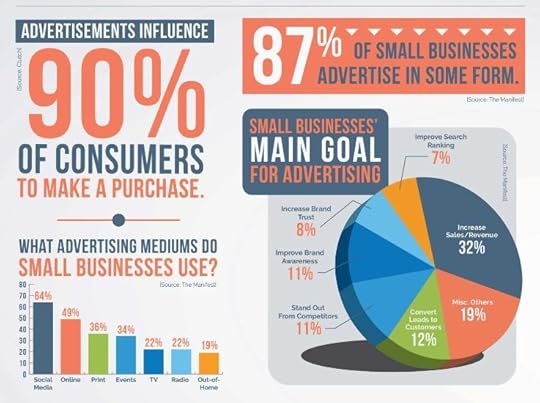
Source: Johntalk.com
Ad spending in the US digital advertising market is expected to hit $271.20 billion by the end of 2023.
Internet advertising lets you reach way more people than traditional methods like print ads or commercials. And get this – it costs a fraction of the price!
With online ads, you can precisely target your perfect potential customers based on things like:
LocationInterestsShopping habitsAnd more!It’s like a laser beam versus a spray bottle. Online advertising puts your message right under the noses of those most likely to be into what you’re selling.
You get insane amounts of data too – impressions, clicks, sales. You name it. This helps inform where to spend your limited advertising budget to get the biggest bang for your buck.
And if something isn’t working, you can tweak or pause ads instantly. No waiting around for the next print issue or air time. Digital advertising is lightning fast.
Really, every business needs to be where their customers hang out. And where is that? Online! On social media platforms, YouTube, and search engines. Setting up ads on these major platforms means you’re right there when people are looking for what you offer.
So don’t let your business get lost in the shuffle. Strategic online ads are your megaphone, spotlighting what makes you great.
Turn up the volume and watch those sales start ringing!
Understanding Your Target AudienceLet’s talk about your ideal target audience. The people you want to sell to. Your potential customers.
Getting inside their heads is super important for your digital marketing plan. You have to know what makes them tick before you try tickling their fancy with your paid ad!
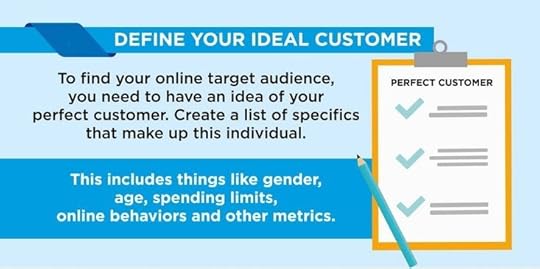
Source: greengeeks.com
Ask yourself these questions about your potential customers:
What are their hopes, dreams, and fears?What motivates them to buy?Where do they hang out online?What social media platforms and search engines do they use daily?What types of content do they engage with?How can your business solve their problems?Essentially, you want to be able to walk a mile in their shoes. Empathize and understand what makes them interested in your business. How can you light up their lives?
This insight is like a compass, pointing to where to focus your advertising to catch their attention.
It also helps you speak their language in your ads. Use words and images they can relate to. Feel their vibe. Does your audience appreciate humor or a more serious tone?
Crafting online ad campaigns with a laser focus on your prospects’ needs and behaviors is how you go from robotic spam to authentic engagement.
So don’t rely on assumptions. Do the research to really get what makes your audience unique. Let their wants and needs guide your strategy. This is how you grab their hearts, minds, and dollars!
Different Types of Online AdvertisingWhat are the different flavors of online advertising? Let’s explore some tasty options for businesses of all sizes.
Search Engine AdvertisingWe all turn to search engines like Google when we need to know something or find something online. Tapping into paid search advertising is a prime way to get your business in front of people actively looking for what you sell.
Search ads work by showing up above or next to organic search results. So when someone searches for “cute rain boots,” your ad for stylish wellies could appear up top.
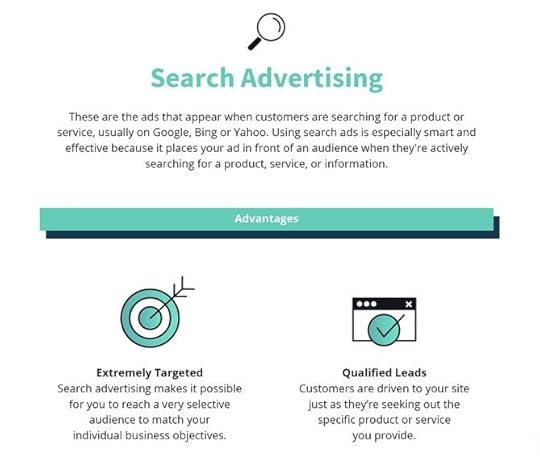
Source: hibu.com
You only pay when someone clicks your search ad to visit your site. And you can target based on keywords, location, and more to laser focus on seekers of your stuff.
Most search ads happen through Google Ads. But other search engines like Bing and Yahoo also provide profitable pay-per-click advertising opportunities.
Just remember – great search ads:
Use keywords related to your products or servicesGrab attention with compelling headlinesSend searchers to relevant pages on your siteGet this recipe right, and search advertising delivers customers on a silver platter!
Social Media AdvertisingWith billions of active users, social platforms like Facebook, Instagram, TikTok, and LinkedIn are online hot spots.
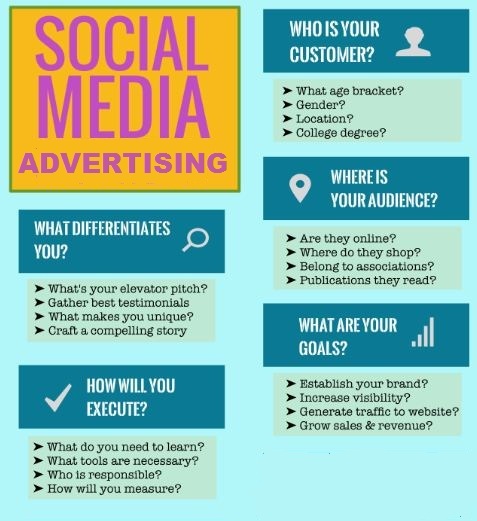
Source: mariapeaglerdigital.com
Setting up ads on social media can help you:
Grow your communityBoost brand awarenessPromote contentAnd drive sales!The key is placing ads on the specific social sites where your audience spends time.
You can target users by location, interests, behaviors, and more. Your ads appear seamlessly in their feeds. It’s a natural way to engage.
The formats are diverse, from photo and video ads to carousels and boosted posts.
And easy tracking means you see what content and messaging perform best. Keep honing your social media advertising approach for killer results!
Display AdvertisingBeyond search and social, you can capture eyeballs with display advertising across the web.
Display ads include:
Banner adsVideo adsRich mediaAnd more!These visual ads help promote your business by increasing visibility and brand impressions.
Strategically place display advertisements on sites that attract your target audience. For example, fitness ads on health sites.
Keep display ads crisp and engaging. Mind the image file sizes – you want fast-loading ads. And test different calls to action. Display advertising works great as a brand supplement to search and social efforts.
Native AdvertisingNative advertising aims to blend ads into the natural content and flow of websites. This makes them less disruptive and obvious than banners and popups.
Examples are things like:
Sponsored articlesRecommended product listsBranded contentPodcastsAnd more!The trick is making native ads match the style and tone of surrounding content. Make them informational and useful to appeal to your audience.
When done right, native ads feel organic rather than salesy. Use them to raise awareness and nurture prospects through the buyer’s journey.
Native advertising requires more effort than standard display ads. But the seamless integration can really pay off!
There you have it! A quick tour of popular online advertising approaches. Try different formats to see what resonates best with your audience and goals. The digital buffet is packed with tasty options. Time to dig in!
Developing an Effective Online Advertising StrategyYou’ve got your audience locked and ads picked. Now it’s time to bring it all together into a rock-solid game plan – your digital advertising strategy!
This is like the blueprint that guides your renovations to create an amazing advertising house. Without it, you’re just swinging a hammer blindly.
Let’s talk about steps to build your strategic foundation…
First, get crystal clear on the goals for your online advertising campaigns.
Do you want to:
Generate more website traffic?Get more sales leads?Increase brand awareness?Engage existing customers?Or achieve some other goal relevant to your business?Defining your wish list keeps your efforts focused. It also gives you metrics to track so you can evaluate success.
Next, pick which online advertising channels make the most sense for your business. We covered a few popular ones earlier. We’ll discuss more advertising channels in the next section of this guide.
Consider factors like:
Where does your audience spend time online? On which sites and platforms?Which ad formats resonate best with your target users?What budget and resources do you have?Choose one or two channels to start and expand from there. There is no need to be everywhere at once.
Now for the money talk. Figure out how much budget you can allocate towards paid advertising across your selected channels.
Be sure to factor in things like:
Campaign management timeAd creation (design, copywriting)Testing different optionsHaving a clear sense of budget and an expected ROI helps inform where to invest and how to measure success.
And that’s the bird’s eye view! Turn your strategy into an actionable plan with specific campaigns, budgets, and tasks. Then get out there and start advertising online like a boss!
10 Top Platforms to Advertise OnlineThe online world is one big advertising display board with many sections. Let’s explore some of the best online advertising platforms where you can promote your business.
GoogleAs the #1 search engine, Google gets an estimated 8.5 billion daily searches. Capitalize on this insane traffic with Google Ads.
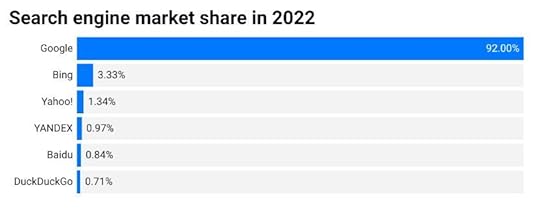
Source: Oberlo.com
Google ads options include:
Search ads – Appear above organic results for keywords related to your bizDisplay ads – Graphical ads on Google sites and partner networksVideo ads – Promote your brand with YouTube video adsShopping ads – Showcase products people are browsing to buyGoogle allows you to laser target your audience and only pay when people engage. Google Ads is a juggernaut for a reason.
FacebookWith billions of active users, Facebook is a beast for promoting brands.
Facebook advertising lets you:
Target users with precision based on traits like interests, behaviors, and moreRaise awareness with video and image ads in the News FeedDrive conversions from website clicks to catalog salesTrack people who’ve previously visited your site people with retargeting adsThe platform makes it easy to create and test different ad variations. And Facebook Pixel helps track conversions. The Facebook platform has a huge reach, great targeting, and robust analytics to power your social media marketing efforts.
YouTubeYouTube sees over a billion hours of video watched daily. Stand out with YouTube Ads like:
Pre-roll ads before videos playOverlay ads that pop up in videosMasthead text ads on YouTube’s homepage
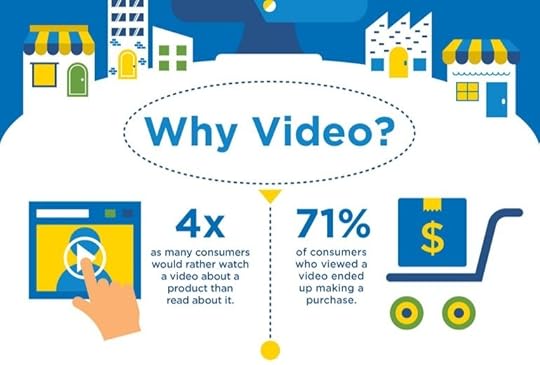
Source: score.org
Video marketing can grab more eyeballs. YouTube’s targeting and audience data enable next-level relevance. Ads on YouTube work great for direct response marketing.
InstagramTap into Instagram’s one billion monthly active users with ads in-feed and in Stories. Options include:
Image and video adsCarouselsStickers and filtersShoppable postsVisual content thrives on Instagram. Drive brand lift and direct response with creative that inspires.
X (Formerly Twitter)Promoted Tweets, Trends, and Accounts help amplify your presence on X. Benefits include:
Real-time conversations with engaged usersVarious ad formats fit naturally in feedsTargeting by keywords, interests, behaviors, and morePromoted content can boost awareness, engagement, and sales if your audience is on X,
LinkedInLinkedIn ads are a great way for businesses to reach professionals! With over 900 million registered users on the platform, you can advertise with:
Sponsored content in feedsText adsMessage ads that drive conversationsTarget by job role, industry, skills, and other filters relevant to business buying. More than 61 million companies are on the platform, and it’s highly suitable for your B2B promotions.
AmazonAmazon’s ad platform lets you promote products people are primed to purchase. Ads types include:
Sponsored Products – Target keywords relevant to your listingsSponsored Brands – Build awareness in search resultsDisplay Ads – Banners and other creatives on and off AmazonOptimizing campaigns can really increase product visibility and Amazon sales.
SnapchatReach younger demographics on this visual messaging app. Ad options include:
Commercials of up to 3 minutesSponsored AR LensesFilters and LensesStory AdsThe vertical format lends itself well to mobile. Snapchat can potentially reach up to 575.7 million individuals, representing 7.2% of the world’s population. If Snapchat is where your audience is, advertise there!
PinterestInspire people browsing for ideas with Promoted Pins on this visual discovery platform. You can:
Boost existing Pins for wider reachTailor for specific interests and behaviorsDrive traffic or conversionsPinterest ads are great for lifestyle brands looking to engage buyers seeking inspiration.
BingThough smaller than Google, Bing still sees millions of searches daily.
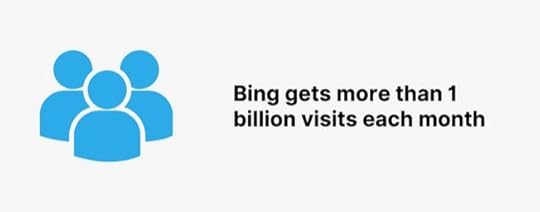
Source: backlinko.com
You can increase visibility on Bing with:
Keyword-targeted Search Network adsGraphical display adsRemarketing and similar audiencesCosts are often lower for Bing Ads. Advertising on Bing is worth exploring to supplement Google and other platforms.
There you have it! Ten major online advertising options with unique audiences and tactics. Pick the best platforms for your business goals and let the promotions begin!
Ad Copy and Creative DesignAds are an effective way to grow your business. But you need compelling ad copy and visuals to power them.
Words matter big time in advertising. Your ad copy needs to grab attention and persuade people to act instantly.
Here are some tips for stellar ad copy:
Focus on customer benefits and how you solve needsUse concise, scannable sentences in an active voiceSpeak to your audience directly like you’re having a chatSprinkle in power words that provoke emotion or urgencyAsk questions to engage readersEnd with a clear CTA that tells people what to do next
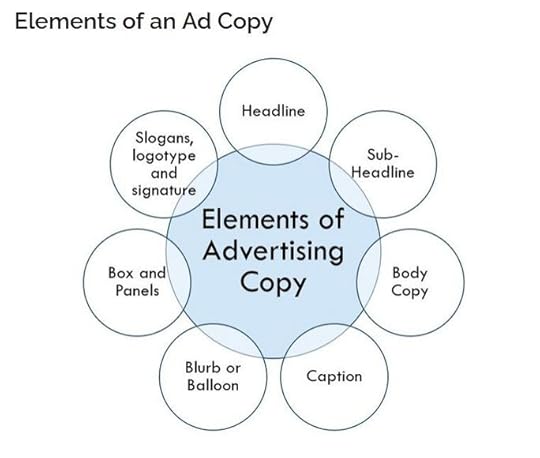
Source: beingintelligent.com
It takes testing different ad copy to see what resonates most. Aim for a balance between informative and conversational. Finding your brand’s tone and voice takes experimentation.
Now, let’s talk about eye-catching visuals. Strong ad creative aligns with your brand style and messaging.
For images and video, consider:
Use high-quality files that load fastShow real people using your product or serviceConvey the desired emotion or experienceLet your brand personality and style shine throughAgain, testing is key. Try different images, fonts, colors, and arrangements to see what pops.
An ad widget like Smartmockups or Crello can help design variations quickly.
Run A/B tests to learn what visuals and copy perform best. This is how you go from stabbing in the dark to developing winning formulas informed by data.
With compelling ingredients – words, visuals, and a clear CTA – you’ll whip up ads that convince and convert. Hone your recipe with relentless testing and optimization.
Monitoring and OptimizationYou did it – campaigns are running, and ads are working their magic! But the real work has only just begun. Now, it’s time to monitor those ads and optimize based on what the data tells you.
When you first launch campaigns, expect to be in proof of concept mode. You’re testing different elements, like targeting, creative, placements, etc., to see what gains traction. Don’t get married to any one approach too early.
Stay glued to your campaign analytics to spot opportunities. Depending on the platform, analyze metrics like:
ImpressionsClicksCTRConversionsCPC/CPALook for trends and insights about what is and isn’t resonating. Then, use what you learned to refine targeting, bids, creatives, and messaging to improve performance.
For example, if a certain ad copy is getting lots of clicks but low conversions, try a version focused more on benefits or proof to assuage concerns.
Optimizing is an ongoing process of incremental improvements through constant testing. Don’t be afraid to experiment with new ideas or even pause/remove elements that aren’t working.
While monitoring analytics, also keep an eye on the bigger picture of how your campaigns align with overall goals. Check if tactics lead to vanity metrics like clicks but no actual business growth.
Online marketing and advertising require diligence, patience, and vigilance. There will always be new opportunities to try that might yield better results. Treat optimization as a habit, not a one-off task.
With regular refinement guided by data, you’ll gain clarity on what works best for your audience and business. Then, you can double down on winning formulas that deliver good ROI and help your paid marketing campaigns soar!
ConclusionAnd that’s a wrap! In this guide, we explored various aspects of online ad campaigns.
With the right knowledge, online advertising stops being a stab in the dark. It becomes a strategic tool to connect with customers and grow your small business.
But who has time to keep up with the ever-changing world of digital advertising? That’s where working with experts pays off.
Enter AdvertiseMint!
At AdvertiseMint, we become an extension of your team, handling the heavy lifting so you can focus on your business. Our paid advertising services create effective ad campaigns tailored to your goals.
We will promote your products or services to target audiences across major platforms like Google, Facebook, Instagram, TikTok, Snapchat, etc. The focus is increasing your ROI.
We’ve successfully done it for many businesses like yours and want to do it for you too.
Ready to turn online advertising into an engine that drives your profits, sales, and brand growth?
It starts with a quick consultation with one of our ads experts.
Click here to request a FREE Facebook Ads consultation now!
What is Conversion Rate?
Conversion rate refers to the percentage of visitors on a website, app, or digital platform who take a specific desired action, often culminating in a sale, sign-up, or any other measurable event.
2. How to Find the Conversion Rate?Determining the conversion rate is straightforward. It’s the ratio of total conversions to the total number of visitors multiplied by 100 to get a percentage.
Formulaically:
Conversion Rate=(Total Visitors/ Total Conversions)×100
Here is a hypothetical example:
Let’s say you run an online store that sells handmade candles. In a given month:
Total Visitors to Your Website: 5,000Total Conversions (Purchases Made): 150To calculate your conversion rate, you can use the formula provided earlier:
Conversion Rate=(Total VisitorsTotal Conversions)×100
Plugging in the numbers:
Conversion Rate=(5,000150)×100≈3%Conversion Rate=(1505,000)×100≈3%
In this example, your conversion rate would be approximately 3%. This means that out of every 100 visitors to your website, around 3 make a purchase.
Understanding your conversion rate in real scenarios like this can help you gauge the effectiveness of your website and marketing efforts. It allows you to track progress over time and identify areas you may need to optimize to improve your conversion rate.
3. Why Are Conversion Rates Important?Conversion rates stand at the intersection of user experience and business profitability. Their importance is multi-faceted and spans across various aspects of digital marketing and operations:
Performance Indicator:Conversion rates are the pulse of any online business, offering a real-time measure of how well your website or campaigns are performing. They reveal the immediate impact of your efforts.
ROI Measurement:Each visitor to your site represents an investment. A higher conversion rate means a more rewarding return on investment (ROI), showing that your marketing and operational strategies are effectively converting visitors into valuable actions.
User Experience Gauge:A healthy conversion rate often signifies an exceptional user experience. Websites that seamlessly cater to their audience’s needs and preferences tend to enjoy a higher percentage of conversions, reflecting a well-crafted user journey.
Strategic Insight:By tracking conversion rates, businesses gain valuable insights into the effectiveness of their strategies and tactics. It’s like a compass guiding you toward what’s working and what may need adjustments.
Financial Health:Beyond the numbers, a high conversion rate directly translates into more revenue. Whether it’s sales, sign-ups, or other valuable actions, an improved conversion rate directly impacts your bottom line, ensuring a healthier financial state.
4. What Is a Reasonable Conversion Rate?Industry benchmarks vary, but a “good” conversion rate generally hovers around 2-5% for most online platforms. However, it’s essential to understand that this number fluctuates depending on factors like industry, product, and competition.
5. What Is a Reasonable Conversion Rate for an E-commerce Business?For e-commerce businesses, average conversion rates typically lie between 1% to 3%. However, top-performing sites can sometimes boast rates as high as 5-7%. It’s crucial to benchmark against similar businesses and continually optimize.
6. How Do We Increase the Conversion Rate?Boosting your website’s conversion rate requires a strategic approach aimed at engaging and persuading your visitors. Here are several effective strategies to consider:
1. A/B Testing:One of the most potent tools in the conversion rate optimization toolbox, A/B testing, involves experimenting with different elements on your website. By comparing two web page versions, you can determine which design, content, or layout resonates more with your audience. This data-driven approach helps you refine your site for maximum impact.
2. Improve Site Speed:In the digital age, speed matters. Slow-loading pages can lead to frustrated visitors who quickly bounce away. Ensuring fast load times enhances user experience and reduces bounce rates, ultimately improving your conversion rate.
3. Clear Calls-to-Action (CTAs):Your CTAs serve as signposts guiding visitors toward desired actions. Make sure they are concise, visible, and compelling. Use action-oriented language that leaves no room for ambiguity. A well-crafted CTA can significantly increase the likelihood of conversion.
4. Responsive Design:With the increasing use of mobile devices, a responsive design is crucial. Ensure that your website adapts seamlessly to different screen sizes and devices. A mobile-friendly design enhances user experience and encourages conversions from a broader audience.
5. Compelling Content:Quality content that addresses your audience’s needs and pain points can captivate and persuade. Engage your visitors with informative, relevant, and persuasive content that builds trust and encourages action.
6. Build Trust:Trust is a fundamental element of conversion. Incorporate trust signals such as customer testimonials, security badges, and transparent policies to instill confidence in your visitors.
Implementing these strategies and continually analyzing the results, you can incrementally improve your conversion rate, ensuring that more of your website’s visitors take the desired actions, ultimately driving business growth.
7. What Is Conversion Rate Optimization?Conversion Rate Optimization (CRO) is the systematic process of increasing the percentage of website visitors who take a desired action, whether purchasing a product or signing up for a newsletter. It involves understanding user behavior and tweaking website elements to facilitate conversions.
8. Which Three of the Actions Can Improve Your Conversion Rate?Among the various strategies available for enhancing your conversion rate, these three actions have demonstrated consistent effectiveness:
1. Enhance User Experience (UX):Your website’s usability and overall user experience are pivotal in driving conversions. Simplifying navigation, ensuring mobile compatibility, and optimizing page load times are all critical elements of a user-friendly website. When visitors can effortlessly find what they’re looking for and interact with your site on any device, they’re more likely to convert.
2. Leverage Customer Reviews:Positive customer reviews serve as powerful social proof. It builds trust and confidence when potential customers see that others have had positive experiences with your products or services. Encourage satisfied customers to leave reviews and prominently display them on your website. Genuine feedback can reassure hesitant visitors and tip the scales towards conversion.
3. Implement Retargeting Strategies:Retargeting strategies allow you to re-engage with users who’ve previously shown interest but haven’t taken the desired action. By delivering targeted ads or personalized content to these users, you can gently guide them back to your site and encourage them to complete the conversion process. This method can be particularly effective in nurturing leads and recovering potential lost opportunities.



